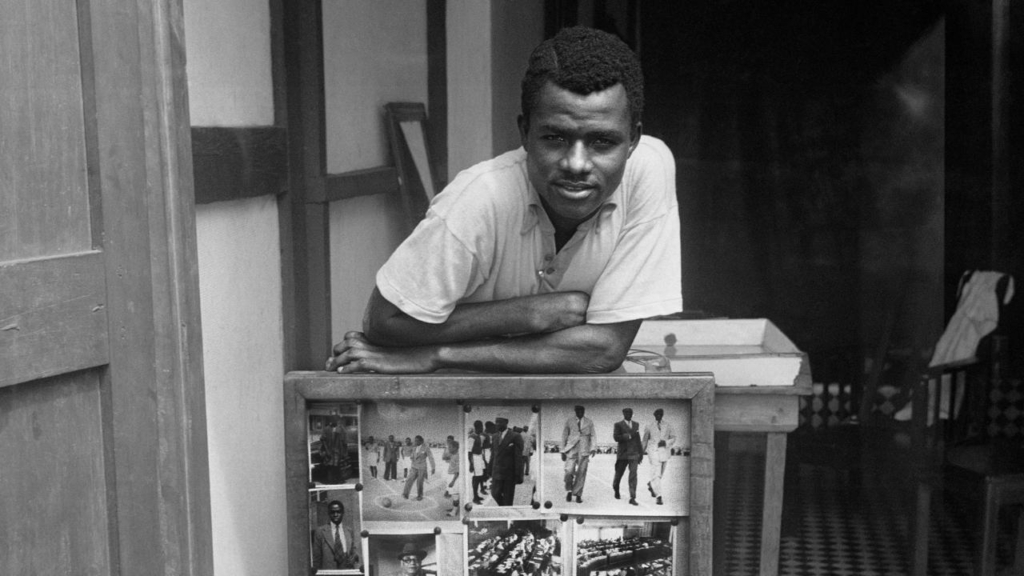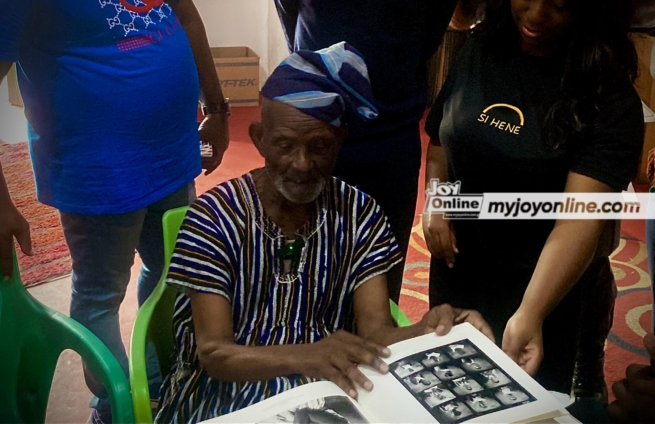"I never met him but I know he was very strict, I am also told that I have some similar traits to him," a curious young man retorted after just coming out of a room full of volunteers helping out at a workshop in Jamestown, Accra.
Papa Kofi Darko was referring to his grandfather who he never met in his lifetime.
But he still holds close to his heart the old photographs and stories handed down to him about the disciplinarian Presbyterian priest he was and some apparently similar attributes they share to which he jokingly says “I don’t know how true that is.”

“I am just grateful that I am still able to experience him and hear stories about him after all these years,” the bespectacled Kofi told me at a digital archiving workshop in Accra where dozens of others had gathered as well.
Photographs are not just the freezing of time, they hold memories that evoke emotions words cannot. I guess that’s why they say a picture is worth a thousand words.
Si Hene was nearing the end of day 3 of its workshop, the Vanishing Past and I was conversing with its Founder, Rita Mawuena, an artiste whose works usually reflect Ghanaian royalty and cultural influence.
In May last year, Rita had Accra stunned with her ‘In the World not of the World’ exhibition which centred around majestic quintessence in the local traditional setting.
But today wasn’t about colourful umbrellas nor traditional ‘Ahenfie’ regalia, this time it was about the ordinary person.
The memories that had been tucked away in decaying copies of photographic paper which conveyed images of essential value to people.
Negatives that had been transformed into the black and white images that underpinned the shaping of generational stories that were told to visitors in each home via a photo album that sat at the centre table of almost any vintage Ghanaian home.
The 3-day community archiving workshop was to help digitise old images and documents as a way of enhancing their durability and restoring the promise that these stories behind them will be told without compromising the original form in which their essence was captured.
So patrons that walked into the Jamestown Café weren’t looking for much, but the simple motive to preserve that one dear family image to remind them of how that past felt like.
It has been a rainy couple of weeks in Accra but that did not deter residents from coming out.
Rita did not take this for granted.

In the open compound outside under the gathering clouds for what may have been another episode of the day’s light intermittent showers, the Si Hene founder lamented that “literally, our history is vanishing, just because photos are getting destroyed, we are not really seeing the importance of photography within our identity as well…”
This is why she decided to put up the event – to digitise, old photographs, documents, or stories.
However, she did not expect the level of submissiveness that was demonstrated by the audience and the vulnerability shown by the residents.
“And even for people to say that ‘okay I have all my family photos, I have hundreds, here you go’, just being able to feel that wow, you’re literally in someone’s house within their photo album or an envelope,” she said.

“We have to also kind of think of our families as museums, you’re not going to let anyone and everyone listen to those stories and see these photos because some of these photos are very important to you. You might cherish them or they might actually show memories that you maybe haven’t actually talked about before, and I think you really have to trust that person that you are actually having that conversation with. I think for that, it has shown me that this is something that is needed.”
Two octogenarian friends were a prime examples of this experience when they walked in that Sunday.
Before I get into their interesting encounter, the event was also geared towards celebrating legendary Ghanaian photographer, James Barnor and the celebration of his 95th birthday.
Back to my two uncles. Between the well-positioned ornamental plants in the café’s garden were sat these two old friend from Jamestown.
Having come by from church, 70-year-old, Joshua Annor flipped through the pages of one of the books written about Frederick Seton James Barnor.
Some images from the 50s and 60s tickled their fancy. Occasionally, Mr Annor – an avid fan of Barnor’s work - would show his friend images and they would both point to areas in present-day Ghana, recounting how much the aesthetics of Ghana’s landmarks have changed.

After every few turn of pages, he would just say to his friend “James Barnor has done really well,” and then return to moisturize his thumb with a quick flick over the tip of his tongue.
He told me that many of the images were nostalgic and was glad that Mr Barnor documented these special moments.
In his coffee newsboy hat, Mr Annor was just getting to how appreciative he was about the works when he spotted another of James’ photos that took him aback – The Accra Race Course.
That photo was taken during Ghana’s Independence Day celebration in 1957.

“Those good old days… then life was free and didn’t care about anything. We were kids though, but we were able to follow big brothers to places to watch a whole lot,” he said while approaching the exit.
The previous day, I encountered an Associate Curator for Photography for the Musee National d’Art Moderne/ Centre Pompidou in France, Damarice Amao.
She led a team to put together a retrospective book of works titled ‘James Barnor, The Road Maker.’

The book compiled photos from James’ career and flaunted his work as a true colourist.
Reflecting on her work around the man, Damarcie was ecstatic about the attention given to James Barnor as he celebrated this milestone on his home turf.
Back on the compound, Rita Mawuena has been explaining the Barnor factor in this specific archiving workshop.
Explaining how this ties into James’ legacy she said “The thing about James’ archives is that he has so many photos of everyday life of Ghana. So now how do we also now go into these family archives and really see what our families were within the past like within the 1950s, ‘60s and 70s.”

As our chat progressed I could hear prompts in the background from some Si Hini protocol team members.
After listening through the external but pulsatingly loud whispers while Rita spoke, I remember telling her during the filming: “I think James Barnor is here.”
Without flinching, the Si Hene founder sprang out of her seat and made her way towards the main scanning area.
And there he was, the man of the moment, who is being celebrated for his stellar work, now live in colour – which he is credited for introducing in the 1970s...lol.
For nearly 70 years, James’ work has created the timeline for Ghana’s transition in a very eclectic way – a true reflection of a body standing the test of time.
From documenting Accra’s changing landscape to photographing icons who have etched their names in the annals of the country’s history, he has seen it all.

At a young age, Frederick Seton James Barnor was charged to teach pupils how to weave baskets.
It was during one of those sessions that the headmaster of the basic school where he plied that trade gave him a plastic Kodak Brownie camera to play around with.
As a committed 17-year-old at the time from a family of photographers, the rest was history.
After a botched move to become a police officer and a subsequent apprenticeship with his cousin, J.P Dodoo, James set up his own studio called FS James Barnor’s Quick Photo Services.
Everything the photojournalist, portraitist, and lifestyle photographer has touched since then has turned gold.

As the first staff photographer employed at Daily Graphic, he has made impressions far and wide including South Africa’s first black lifestyle magazine, Drum leaving Accra draped with his works at exhibitions for to commemorate his 95th.
Globally, he has left his mark in every way you can think of as he continued his work in London as a freelancer doing marvelous work in top publications, and fashion images among others.
His images show the fast pace of the multicultural changes in London – where he has lived since 1994 after traversing Accra and the British capital for about 35 years prior.
- Read also: Visual artist Tiffanie Delune evokes spirituality, identity, representation in Accra exhibition
Today, he is a national asset who most photographers worldwide look up to for inspiration as one of the very few of his kind ever to live.
This is why his appearance at the Jamestown Café brought the place to a standstill.
It was surreal. He was back in the town where it all started - clothed in his smock and surrounded by his people united in celebration of the mission he set out to accomplish.

I looked as he sat, seemingly enthused and looking up at his vintage works that had been interpolated in the artwork for the day’s event.
One could almost hear his thoughts loudly trying to restrict the amazing reaction as he sat still in his calm and unassuming demeanor – and of course, reciprocating pleasantries with the excited attendees.
With all the international accolades in a bag, what else does fulfillment mean to this man?
From Mohammed Ali to Dr Kwame Nkrumah – name all your greats, and chances are they may have been touched by the powerful lens of James Barnor at some point.
Could it be the acceptance by the people of the heritage and the tradition that gave him a shot?

This thought had been lingering for some time now, which is why I decided to ask the nonagenarian;
Even though you’ve been celebrated globally, how does it feel to be celebrated by your own people back home?
He described it as exceptional!
“I have a message for Ghana which may not be as meaningful outside. It should be here. I am happy that I am given the audience, the voice to celebrate it here and be heard.”
And the message was clear, and if the series of activities lined up by creatives to celebrate him was anything to go by, the messengers are now in multitudes.
For much of his earlier years, Mr Barnor’s work did not get the acclaim it enjoys now until he was about 78 years old.
That was when his portraits stunned many during a Ghana @ 50 jubilee exhibition at the Black Cultural Archives. From there, the only way has been up.
The photos had aged like fine wine and he would go on to do many including his first major solo retrospective of his catalogue in 2010.
It was hosted at Rivington Place in London and called ‘Ever Young: James Barnor’ – named after his first studio back in Accra ‘Ever Young’ - and received wide coverage by the English press.
For James, the urge to make an impact is his drive. The will to leave a seed of commitment and hope to foster development in the next generation of freethinking African photographers is at the core of Barnor’s delivery – and he still holds that principle dear.
At the archiving workshop, another female photographer and volunteer could not help but make it known to James how much his legacy has fueled her passion for photography.
Struck by this development, Mr Barnor said “These things make me happy.”

"Otherwise I will say 90 is enough, 95 is too much so I better go. But when I meet people who are inspired by me I want to stay longer and inspire more people."
With lots of energy, he walked the gathering through each story that made his already exceptional stories even more unique.
He did this with enthusiastic readiness as if he was 25 all over again.
At 95, James Barnor stands as a towering figure in Ghana’s history.

Just as his work has depicted the transitions in societies, the legendary creative genius has seen the changing phases of life.
Even at this age, Frederick Seton James Barnor sees life in the mundane and keeps capturing hearts and we continue to see the world through his eyes.
The author, Kenneth Awotwe Darko is a journalist, culture, arts and music enthusiast, and social media analyst.
Follow him on Twitter via @TheKennethDarko on Facebook, Kenneth Awotwe Darko and @TheKenDarko on Instagram.
Email: Kenneth.darko@myjoyonline.com
Latest Stories
-
Mustapha Gbande slams Minority over dumsor levy criticism
6 minutes -
Gospel music is a tool for transformation, not entertainment – Esther Godwyll
12 minutes -
EC must adopt real-time technology for instant election result declaration – Kwabena Bomfeh
17 minutes -
Minority laments budget delays; says ‘no funds to work’
20 minutes -
43-year-old barber found dead in his shop in Effia-Kwesimintsim
25 minutes -
More than 500 galamseyers arrested in the last five months – Government
26 minutes -
Government unveils theme for National Day of Prayer and Thanksgiving
28 minutes -
Stakeholders validate draft of new Fisheries Bill
44 minutes -
Ghana and Malawi strengthen Biodiversity Data Management
45 minutes -
Government should consider youth –led initiatives in climate change issues
45 minutes -
Calls for comprehensive national policy to tackle plastic pollution intensifies
46 minutes -
Mahama receives final report of National Education Forum
46 minutes -
Kofi Adjorlolo discloses he wanted to be a musician, not an actor
52 minutes -
Entrepreneurship is about survival in Africa – McDan
1 hour -
GRA postpones implementation of GH₵1 fuel levy
1 hour

